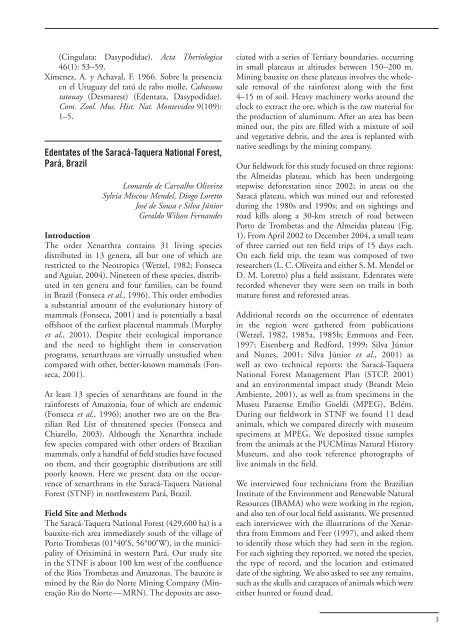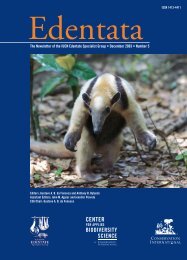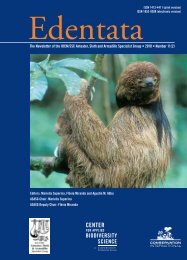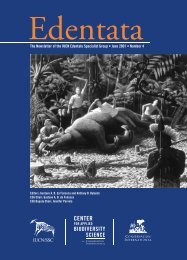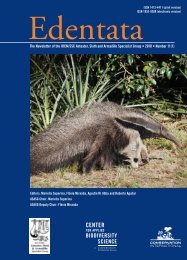Edentata 7 - Anteater, Sloth & Armadillo Specialist Group
Edentata 7 - Anteater, Sloth & Armadillo Specialist Group
Edentata 7 - Anteater, Sloth & Armadillo Specialist Group
- No tags were found...
You also want an ePaper? Increase the reach of your titles
YUMPU automatically turns print PDFs into web optimized ePapers that Google loves.
(Cingulata: Dasypodidae). Acta Theriologica<br />
46(1): 53–59.<br />
Ximenez, A. y Achaval, F. 1966. Sobre la presencia<br />
en el Uruguay del tatú de rabo molle, Cabassous<br />
tatouay (Desmarest) (<strong>Edentata</strong>, Dasypodidae).<br />
Com. Zool. Mus. Hist. Nat. Montevideo 9(109):<br />
1–5.<br />
Edentates of the Saracá-Taquera National Forest,<br />
Pará, Brazil<br />
Leonardo de Carvalho Oliveira<br />
Sylvia Miscow Mendel, Diogo Loretto<br />
José de Sousa e Silva Júnior<br />
Geraldo Wilson Fernandes<br />
Introduction<br />
The order Xenarthra contains 31 living species<br />
distributed in 13 genera, all but one of which are<br />
restricted to the Neotropics (Wetzel, 1982; Fonseca<br />
and Aguiar, 2004). Nineteen of these species, distributed<br />
in ten genera and four families, can be found<br />
in Brazil (Fonseca et al., 1996). This order embodies<br />
a substantial amount of the evolutionary history of<br />
mammals (Fonseca, 2001) and is potentially a basal<br />
offshoot of the earliest placental mammals (Murphy<br />
et al., 2001). Despite their ecological importance<br />
and the need to highlight them in conservation<br />
programs, xenarthrans are virtually unstudied when<br />
compared with other, better-known mammals (Fonseca,<br />
2001).<br />
At least 13 species of xenarthrans are found in the<br />
rainforests of Amazonia, four of which are endemic<br />
(Fonseca et al., 1996); another two are on the Brazilian<br />
Red List of threatened species (Fonseca and<br />
Chiarello, 2003). Although the Xenarthra include<br />
few species compared with other orders of Brazilian<br />
mammals, only a handful of field studies have focused<br />
on them, and their geographic distributions are still<br />
poorly known. Here we present data on the occurrence<br />
of xenarthrans in the Saracá-Taquera National<br />
Forest (STNF) in northwestern Pará, Brazil.<br />
Field Site and Methods<br />
The Saracá-Taquera National Forest (429,600 ha) is a<br />
bauxite-rich area immediately south of the village of<br />
Porto Trombetas (01°40′S, 56°00′W), in the municipality<br />
of Oriximiná in western Pará. Our study site<br />
in the STNF is about 100 km west of the confluence<br />
of the Rios Trombetas and Amazonas. The bauxite is<br />
mined by the Rio do Norte Mining Company (Mineração<br />
Rio do Norte — MRN). The deposits are associated<br />
with a series of Tertiary boundaries, occurring<br />
in small plateaus at altitudes between 150 –200 m.<br />
Mining bauxite on these plateaus involves the wholesale<br />
removal of the rainforest along with the first<br />
4–15 m of soil. Heavy machinery works around the<br />
clock to extract the ore, which is the raw material for<br />
the production of aluminum. After an area has been<br />
mined out, the pits are filled with a mixture of soil<br />
and vegetative debris, and the area is replanted with<br />
native seedlings by the mining company.<br />
Our fieldwork for this study focused on three regions:<br />
the Almeidas plateau, which has been undergoing<br />
stepwise deforestation since 2002; in areas on the<br />
Saracá plateau, which was mined out and reforested<br />
during the 1980s and 1990s; and on sightings and<br />
road kills along a 30-km stretch of road between<br />
Porto de Trombetas and the Almeidas plateau (Fig.<br />
1). From April 2002 to December 2004, a small team<br />
of three carried out ten field trips of 15 days each.<br />
On each field trip, the team was composed of two<br />
researchers (L. C. Oliveira and either S. M. Mendel or<br />
D. M. Loretto) plus a field assistant. Edentates were<br />
recorded whenever they were seen on trails in both<br />
mature forest and reforested areas.<br />
Additional records on the occurrence of edentates<br />
in the region were gathered from publications<br />
(Wetzel, 1982, 1985a, 1985b; Emmons and Feer,<br />
1997; Eisenberg and Redford, 1999; Silva Júnior<br />
and Nunes, 2001; Silva Júnior et al., 2001) as<br />
well as two technical reports: the Saracá-Taquera<br />
National Forest Management Plan (STCP, 2001)<br />
and an environmental impact study (Brandt Meio<br />
Ambiente, 2001), as well as from specimens in the<br />
Museu Paraense Emílio Goeldi (MPEG), Belém.<br />
During our fieldwork in STNF we found 11 dead<br />
animals, which we compared directly with museum<br />
specimens at MPEG. We deposited tissue samples<br />
from the animals at the PUCMinas Natural History<br />
Museum, and also took reference photographs of<br />
live animals in the field.<br />
We interviewed four technicians from the Brazilian<br />
Institute of the Environment and Renewable Natural<br />
Resources (IBAMA) who were working in the region,<br />
and also ten of our local field assistants. We presented<br />
each interviewee with the illustrations of the Xenarthra<br />
from Emmons and Feer (1997), and asked them<br />
to identify those which they had seen in the region.<br />
For each sighting they reported, we noted the species,<br />
the type of record, and the location and estimated<br />
date of the sighting. We also asked to see any remains,<br />
such as the skulls and carapaces of animals which were<br />
either hunted or found dead.<br />
3


